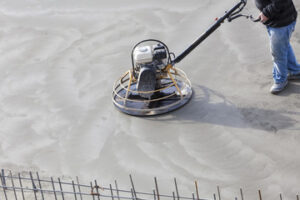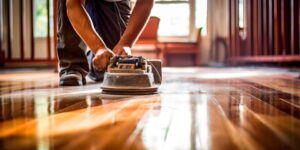Concrete Resurfacing Waco TX is an economical and effective way to improve your property’s surfaces. It’s a great alternative to replacing your concrete, and you can customize the look to suit your needs.

Before you apply resurfacer, make sure the surface is clean and free of failing coatings and debris. You can use a broom to texture the surface for a non-slip finish.
Concrete is known for its durability and versatility in construction, making it a common material used for driveways, sidewalks, patios, and floors. However, it is also subject to heavy foot traffic and weather elements over time, which can lead to cracks, discoloration, and a worn-out appearance. Concrete resurfacing can revitalize these surfaces by adding a new layer of material, masking any flaws and enhancing their look and performance. This process is often much less expensive and easier than a complete replacement, which can require costly demolition and labor.
Resurfacing your concrete can be done in a variety of ways, from basic to more complex. The most basic method involves a simple overlay of concrete, but more advanced techniques can include colorants, stains, textures, and patterns to create an aesthetic that complements the surrounding area. Concrete resurfacing can also be stained with colorants that range from neutral to vibrant, or textured with dyes and finishes. In addition to creating a unique aesthetic, these finishes and tints can help prevent damage from the sun or other environmental factors.
Aside from enhancing your property’s visual appeal, concrete resurfacing can also make the surface more functional. For example, if the concrete has a high traction surface, you can request an additive to improve its slip resistance. This is particularly helpful for outdoor surfaces that are often wet or damp.
When considering the options for your concrete, it is important to consult with experts in the field. They can provide insights into your specific needs and recommend the best solution for your home. They can also provide detailed estimates for both resurfacing and replacement, which will help you weigh the costs and benefits of each option.
Another consideration when deciding between resurfacing and replacement is the level of disruption that each option causes. Resurfacing is generally a more time-efficient and affordable option, as it can be completed without the need for major demolition or excavation. By contrast, replacing the concrete requires extensive labor and machinery, which can be disruptive to your daily life and increase the overall project cost.
Durability
Concrete is one of the most durable materials used in construction projects, but over time it can become damaged due to a number of factors. These include traffic, water penetration and UV damage. These conditions can lead to scaling, flaking and discoloration of the concrete surface. In such cases, concrete resurfacing can be an effective solution to restore the surface. Resurfacing is a cost-effective alternative to replacing the entire concrete slab, and it can also be a great way to enhance the look of your home or business.
In order to achieve successful and long-lasting results, it is essential that the resurfacing process be performed correctly. This includes addressing any underlying issues and thoroughly cleaning the concrete surface. Failure to do so can lead to resurfacing failure and further deterioration of the concrete.
It is also important to choose the right resurfacing product for your specific project. Different products have different application temperatures, curing times and drying requirements. It is recommended that you follow the manufacturer’s instructions and apply the resurfacing material in manageable sections. This will ensure even coverage and a smooth finish.
The concrete resurfacing product typically contains a mixture of cement, polymers and aggregates. It can be applied to the concrete in a thin layer to provide a strong and attractive new surface. The resurfacing material is then troweled to a smooth finish. In addition, it can be colored to match the color of your existing concrete surface.
When properly maintained, resurfaced concrete can last decades. It is a good option for commercial properties that require a hardwearing surface that can withstand heavy traffic, vehicles and weather conditions. It is important to keep in mind, however, that resurfacing will not correct major cracking or heaving of the concrete.
To extend the durability of the concrete resurfacing, it is recommended that you apply a sealant after each cleaning. This will protect the resurfacing from water penetration, staining and UV damage. It is also important to avoid exposure to harsh chemicals such as de-icing salts, oils, gasoline, and acidic substances. These can cause discoloration and surface deterioration.
Safety
Concrete surfaces are sturdy and durable, but they can be subject to wear and tear over time. Heavy foot traffic and environmental elements can cause cracks, stains, and general deterioration. Concrete resurfacing is a quick and easy way to give these areas a fresh new look without the cost of replacing the entire slab. This process involves applying a thin layer of cement-like material over the existing surface, repairing any damage, and then coloring or stamping it to create a custom design.
The resurfacing material used in this process can be made of a variety of materials, including epoxy and polymer-modified overlay systems. These systems combine polymer resins with cement and sand to improve the durability, strength, and appearance of the concrete. Resurfacing can also include nonslip additives to prevent people from slipping and falling when the surface is wet. This can be especially important for outdoor spaces like pool decks and patios.
While resurfacing is an effective cosmetic improvement, it should not be considered a permanent solution to serious concrete problems. It is most appropriate for surfaces that experience minor cosmetic issues or surface damage. Serious cracks, pits, and chips should be repaired using a patching product before the resurfacer is applied.
Before resurfacing, the concrete should be thoroughly cleaned to remove any dirt or debris. A 3,500 psi pressure washer is often used to open up control and expansion joints in the concrete, preventing damage to the underlying structure when the overlay freezes and thaws.
Resurfacing can be performed over a wide range of concrete types, including precast slabs. However, it is not suitable for surfaces with significant structural problems like heaving or settlement. If these issues are present, the concrete should be replaced with a more extensive repair project.
It is important to note that the lifespan of a resurfaced concrete can vary greatly. Its longevity depends on the amount of foot or vehicle traffic, climate conditions, and the maintenance and cleaning routines that are followed. Regularly cleaning the surface, removing any accumulated dirt or moisture, and repairing cracks and chips will extend its life. It is also essential to avoid abrasive activities or heavy vehicles on the surface to reduce the risk of premature wear and deterioration.
Cost
Concrete is one of the most expensive materials to replace in your home. However, it’s far less expensive to resurface an existing concrete surface than tearing up and replacing it. Resurfacing also provides a wide range of design options, including stains, patterns, textures and even stamped overlays.
Resurfacing a concrete surface can hide cracks, discoloration and other damage while improving its overall appearance. Resurfacing is a great option for patios, pool decks and driveways. It’s cost efficient and offers many design options that can complement your outdoor living space.
The costs associated with resurfacing depend on the condition of your existing concrete and any repair work that needs to be done. A pro will assess the concrete and determine if it’s in a condition that can support resurfacing or if further repairs are required. This will help you plan for your budget.
Basic resurfacing without any decorative elements typically costs $3 to $5 per square foot. This includes surface preparation, application of a resurfacing material and sealing. If you want to add color or other decorative elements, you can expect the price to rise.
Before the resurfacing material is applied, the surface must be thoroughly power washed to remove dirt and other debris. This will help ensure the resurfacing material adheres properly and lasts longer. If you’re planning on a DIY project, consider doing the prep work yourself. This can save you time and money by reducing the amount of work that needs to be done by a professional.
The overlay material used in resurfacing acts as a barrier, protecting the underlying concrete from environmental factors such as moisture and UV rays. This extends the lifespan of your concrete and reduces future maintenance costs.
Concrete resurfacing is an economical choice for homeowners because it’s significantly less expensive than replacement and it provides endless design possibilities. It’s also environmentally friendly since it avoids the waste and landfill impacts associated with removing and replacing old concrete.
Resurfacing is a great option for homeowners who are looking to improve their curb appeal, upgrade their concrete surfaces and make their home look more modern. It’s important to choose a reputable and experienced contractor for this type of work. A qualified professional will be able to provide you with examples of previous projects and a detailed quote for your specific needs.
